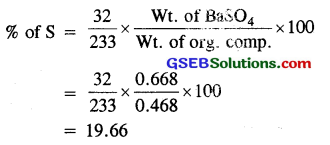Gujarat Board GSEB Textbook Solutions Class 11 Chemistry Chapter 12 Organic Chemistry: Some Basic Principles and Techniques Textbook Questions and Answers.
Gujarat Board Textbook Solutions Class 11 Chemistry Chapter 12 Organic Chemistry: Some Basic Principles and Techniques
GSEB Class 11 Chemistry Organic Chemistry: Some Basic Principles and Techniques Text Book Questions and Answers
![]()
Question 1.
What are hybridisation states of each carbon atom in the following compounds ?
CH2=C=O, CH3-CH=CH2, (CH3)2C=O, CH2=CHCN, C6H6
Answer:
- CH = C = O : sp², sp²
- CH3-CH = CH2 : sp³ sp², sp²
- (CH3)2 C = O : sp³ sp³ sp²
- CH2 = CHCN : sp², sp², sp
- C6H6 : sp²
Question 2.
Indicate the crand nbonds in the following molecules :
C6H6. C6H12, CH2C12, CH2=C=CH2, CH3NO2, HCONHCH3.
Answer:
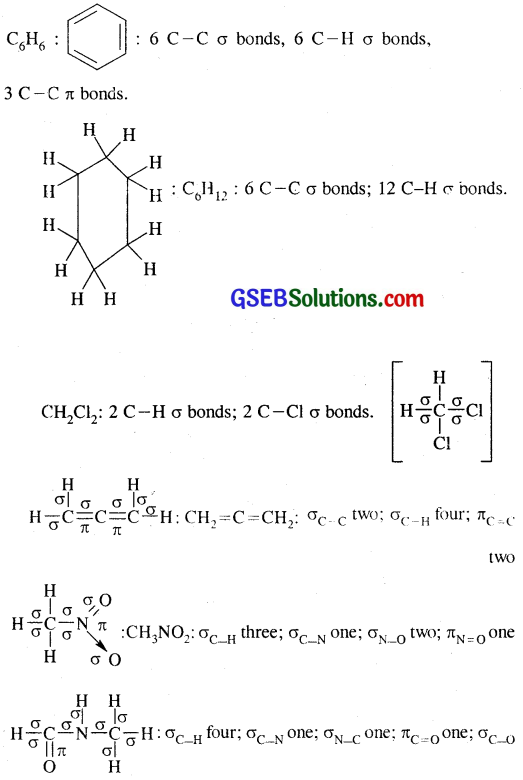
Question 3.
Write bond line formulas for: isopropyl alcohol, 2, 3-Dimethyl butanal, Heptan-4-one.
Answer:
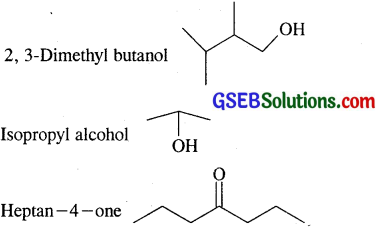
Question 4.
Give the I.U.P. A.C. names of the following compounds :

Answer:
(a) Propylbenzene
(b) 3-Methylpentane nitrile
(c) 2, 5-Dimethylheptane
(d) 3-Bromo-3-Chloroheptane
(e) 3-ChIoropropan-l-al
(f) 2, 2-Dichloroethanol.
![]()
Question 5.
Which of the following represents the correct IUPAC name for the compounds concerned :
(a) 2, 2-Dimethylpentane or 2-Dimethylpentane
(b) 2,4,7-Trimethyloctane or 2,5,7-Trimethyloctane
(c) 2-chloro-4-methylpentane Or 4-chloro-2-methylpentane
(d) But-3-yn-l-ol or But-4-ol-l-yne.
Answer:
(a) 2, 2-Dimethyl pentane
(b) 2, 4, 7-Trimethyloctane
(c) 2-chloro-4-methylpentane
(d) But-3-yn-l-ol.
Question 6.
Draw formulas for the first five members of each homologous series beginning with the following compounds,
(a) H-COOH
(b) CH3COCH3
(c) H-CH=CH2.
Answer:
(a) H-COOH; CH3COOH; CH3CH2COOH;
CH3CH2CH2COOH; CH3 – CH2 – CH2 – CH2 – COOH
(b)

(c) H2C=CH2; CH3-CH=CH2; CH3-CH2-CH=CH2; CH3 – CH2 – CH2 – CH=CH2 and
CH3-CH2-CH2-CH2-CH=CH2.
Question 7.
Give condensed and bond line structural formulas m% identify the functional group (s) present if any, for:
(a) 2, 2, 4-Trimethypentane
(b) 2-Hydroxy-l, 2, 3-propanetricarboxylic acid
(c) Hexanedial.
Answer:

Question 8.
Identify the functional groups in the following compounds.

Answer:
(a) -CHO aldehyde group: —OH hydroxy group; -OMe Methoxy group (ether)
(b)

(c) -CH = CH-NO2 : -HC = CH – alkene group
NO2 – Nitro group. (Ethylenic double bond)
![]()
Question 9.
Which of the two : O2N-CH2-CH2O or
CH3-CH2-O– is expected to be more stable and why?
Answer:
O2N-CH2-CH2O – is expected to be more stable than CH3–CH2O–.
In O2N ← CH2O-CH2–O, due to the -I effect exerted by -NO2 group, there occurs a dispersal of the negative charge, whereas in CH3 → CH2O- due to + I effect exerted by CH3, there occurs an intensification of the negative charge. Dispersal of the charge leads to more stability of the ion.
Question 10.
Explain why alkyl groups act as electron donors when attached to a n system.
Answer:
Due to + I effect, electrons are released towards C atom holding it bond next to it
![]()
Shifting of π electron-pair in a multiple bond at the call of the attacking reagent is termed as Electromeric effect.
Question 11.
Draw the resonance structures for the following compounds. Show the electron shift using curved-arrow notation,
(a) C6H5OH
(b) C6H5NO2
(c) CH3CH = CHCHO
(d) C6H5-CHO
(e) C6H5-C+H2
(f) CH3CH = CHCH+2
Answer:
(a) Resonance structures of Phenol: There are 5 canonical structure for phenol. Phenol is a resonance hybrid of these 5 structures.
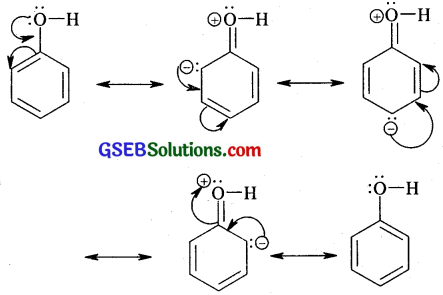
(b) Resonance structures of nitrobenzene : These are the following four resonating structures of nitrobenzene.
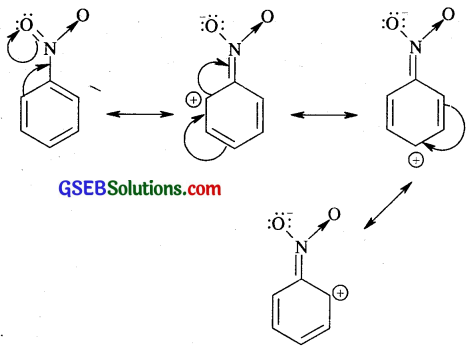
(c) CH3 – CH = CH-CHO
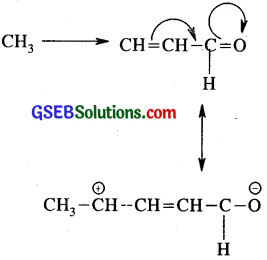
(d) C6H5CHO

(e) C6H5C+H2
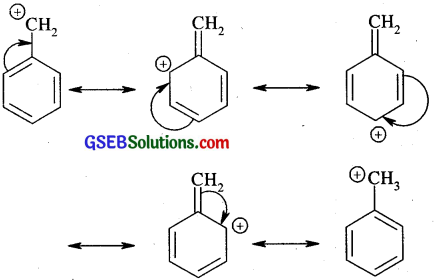
(f)

Question 12.
What are electrophiles and nucleophiles? Explain with examples.
Answer:
Electrophiles : A reagent which is in search of electrons is called an electrophile. It is electron-seeking reagent and takes away a pair of electrons.
Neutral electrophiles. BF3, R; :CR2, AlCl3, FeCl3
Positive electrophiles.
H+, H3O+, Cl+, BR+, I+ \(\stackrel{+}{\mathrm{NO}}\)2, \(\stackrel{+}{\mathrm{NO}}\), R+
They are Lewis acids.
Nucleophiles: A reagent which is in search of a relatively positive centre (nucleus-loving). They are electron-rich species containing at least one lone pair of electrons.
Neutral nucleophiles : \(\mathrm{H}_{2} \ddot{\mathrm{O}}:,: \mathrm{NH}_{3}, \mathrm{R} \ddot{\mathrm{NH}}_{2}, \mathrm{ROH}, \mathrm{RSH}, \mathrm{ROR}\)
Negative nucleophiles : H–, Cl–, Br–, I–, R–, OH–, OR–, SR–, NH–2,CN–, RCOO– etc.
![]()
Question 13.
Identify the reagents shown in bold in the following equations as nucleophiles or electrophiles.
(a) CH3COOH+ HO– → CH3COO + H2O
(b) CH3COCH3 + CN– → (CH3)2C(CN) (OH)
(c) C6H5 + CH3C+O → C6H5COCH3.
Answer:
(a) HO– is a nucleophile
(b) \(\bar { C }\)N is a nucleophile
(c) CH3C+O is an electrophile.
Question 14.
Classify the following reactions in one of the reaction type studied in this unit :
(a) CH3CH2Br + HS– → CH3CH2SH
(b) (CH3)2C = CH2 + HCl → (CH3)2 ClC
(c) CH3CH2Br + HO– → CH2 = CH2 + H2O
(d) (CH3)3 C – CH2OH + HBr → (CH3)2 CBrCH2OH
Answer:
(a) Nucleophilic substitution reaction
(b) Electrophilic addition reaction
(c) P-Elimination reaction
(d) Substitution reaction and rearrangement reaction.
Question 15.
What is the relationship between the members of following pairs of structures? Are they structural or geometrical isomers or resonance contributors?
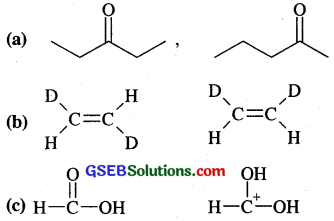
Answer:
(a) They differ in the position of the functional group and are position isomers, (structural isomers)
(b) They are geometrical isomers.

They are resonance contributors.
Question 16.
For the following bond cleavages, use curved-arrows to show the electron flow and classify each as homolysis or heterolysis. Identify reactive intermediate produced as free radical, carbocation and carbanion.

Answer:
(a) ![]()
It is a case of homolytical fission. Free-radicals are formed.
(b) 
It is a case of heterolysis. Reaction intermediate formed is carbanion.
(c) 
It is a case of heterolysis [Heterolytical bond fission] reaction intermediate formed is carbocation
(d) 
It is a case of heterolysis [Heterolytical bond fission] reaction intermediate formed is carbocation.
![]()
Question 17.
Explain the terms Inductive and Electromeric effects. Which electron displacement effect explains the following correct orders of acidity of the carboxylic acids?
(a) Cl3CCOOH > Cl2CHCOOH > ClCH2COOH
(b) CH3CH2COOH > (CH3)2CHCOOH > (CH3)3C.COOH
Answer:
Inductive effect : The displacmeent of a electron cloud along a saturated carbon chain whenever an electron-withdrawing or electron-donating group is present at the end of the chain is called
Inductive effect or the I-effect : This effect weakens steadily with increasing distance from the substituent (electron-withdrawing or electron-donating group) and actually dies down after three carbon atoms.
There are two type of Inductive effects:
(i) If the substituent attached to the end of the chain is electron- withdrawing, the effect is called I effect.

(ii) If the substituent attached to the end of the carbon chain is electron-donating, the effect is called + I-effect.
![]()
The + I effect of some of the atoms or groups in the decreasing order is

Inductive effect is a permanent effect operating in the ground state of the organic molecules and hence is responsible for high, melting point, boiling point and dipole moment of polar compound.
Electromeric Effect:
It involves the complete transfer of electrons of a multiple bond (double or triple bond) to one of the bonded atoms (usually more electronegative) in presence of an attacking reagent. It is called
E-effect:

This effect, is temporary and takes place only in the presence of a reagent. As soon as reagent is removed, the molecule reverts back to its original position.
Electromeric effect is also of two types : + E-efFect and – E effect – If the electrons of the π bond are transferred to that atom of the double bond to which the reagent finally gets attached the effect is called + E effect. For example, addition of acids to alkenes.

If on the other hand, the electrons of the double bond are transferred to an atom of the double bond, other than the one to which the reagent finally gets attached, the effeet is called – E-effect.

Question 18.
Give a brief description of the principles of the following techniques taking an example in each case.
(a) Crystallisation
(b) Distillation
(c) Chromatography.
Answer:
(a) Crystallisation : The process by which an impure compound is converted into its crystals is known as crystallisation. Crystals are the purest form of a substance having definite geometrical shapes.
The impure substance is dissolved in a.suitable solvent in which it is sparingly soluble at room temperature but appreciably soluble at higher temperature. The solution is concentrated to get nearly a saturated solution. When this saturated solution is cooled crystals of the pure substance will separate out. Impure sugar is purified by this method.
(b) Distillation : Distillation involves conversion of a liquid into vapours by heating followed by condensation of the vapours thus produced by cooling. This method is commonly used for those liquids which are sufficiently stable at their boiling points and which contain non-volatile impurities.
If a mixture of two liquids having different boiling points are to be separated then that liquid will be received first in the receiver where B.Pt. is less or vapour pressure is. more. A mixture of toluene and hexane can be separated by this method.
(c) Chromatography : The. technique of separating the components of a mixture in which separation is achieved by the differential movement of individual components through a stationary phase under the influence of a mobile phase. The stationary phase can be either a solid or tightly bound liquid on a solid support, while the mobile phase can be either liquid or a gas. There are major two types of adsorption chromatography. Coloured components from a mixture can be separated by column chromatography.
- Column chromatography
- Thin layer chromatography
![]()
Question 19.
Describe the method which can be used to separate two compounds with different solubilities in a solvent S.
Answer:
Two compounds which have different solubilities in a solvent S can be separated from each other by FRACTIONAL crystallisation. The process involves a series of repeated crystallisations. The mixture of the two compounds in the solvent S is heated so as to make it saturated.
When the hot solution is allowed to cool, the less soluble substance crystallises out first while the more soluble substance remains in the solution. The crystals of first compound are separated from the mother, liquor and the mother liquor is again concentrated and allowed to cool when the crystals of the 2nd compound are obtained.
Question 20.
What is the difference between distillation, distillation under reduced pressure and steam distillation?
Answer:
Distillation mvolves the conversion of a liquid into vapour by heating followed by the condensation of the vapours thus produced by cooling. This method is commonly used for those liquids which are sufficiently stable at their boiling points and which contain non¬volatile impurities.
For example simple organic liquids such as benzene, ethanol, acetone, chloroform, carbon tetrachloride, toluene etc. can be purified by simple distillation. Distillation under reduced pressure, on the other hand, is applicable for the purification of liquids with high boiling points and liquids which decompose at or below their boiling points.
A liquid boils when its vapour pressure becomes equal to the external pressure. Clearly the same liquid will boil at a lower temperature if the pressure on it is reduced. Since the liquid now boils at a lower temperature, the decomposition of the liquid does not occur.
Steam distillation is used for the separation and purification of organic compounds (solid or liquid) from non-volatile organic or inorganic impurities. This method is-applicable to only those compounds which are volatile in steam, insoluble in water, possess a high vapour pressure and contains non volatile impurities.
![]()
Question 21.
Discuss the chemistry of Lassaigne’s test.
Answer:
Preparation of Lassaigne’s filterate : A pea-sized and dried fresh piece of sodium is put in a small ignition tube and heated till sodium melts. A pinch of the given organic compound (or a drop of it if it is a liquid) is now added to the fused sodium and heated again to red hot. The fusion tube contents are now transferred to a china dish containing 10-15 ml of water.
The tube breaks and contents are boiled in the china dish. The solution, after filtration, is called Lassaigne’s filterate. It is used for testing of the elements, N, S, N & S, halogens in the given organic compound.
Test for Nitrogen:

Now to an part of L.F, freshly prepared FeSO4 is added when the following reactions occur. A small amount of H2SO4 is added.

Some of Fe2+ ions are oxidized on heating to Fe3+ ions

This Fe3+ ions give prussian blue colour which comfirms the presence of Nitrogen in the compound.
Test for N & S if present, together

If on treatment with FeSO4 and on heating, blood red colouration is produced, the organic compound contains both N and S together.
If S is present alone

When lead acetate Pb(CH3COO)2 is added in a small quantity to L.F. and acidifed with acetic acid, a black ppt. of PbS is obtained; S alone is present in the organic compound.
Na2S + (CH3COO)2 Pb → PbS + 2CH3COONa
Test for Halogens
Na + X → NaX [X = Cl, Br, I]
From the organic compound
L.F. is boiled with dil. HNO3 and cooled. A few drops of AgNO3 are added.
(a) NaCl + AgNO3 → AgCl ↓+ NaNO3
If a white ppt. is obtained which is soluble, in NH3 but insoluble in HNO3, the organic compd. contains chlorine.
(b) NaBr + AgNO3 → AgBr ↓+ NaNO3
Formation of a pale yellow precipitate partially soluble in ammonia indicate the presence of bromine
(c) 
A yellow ppt. insoluble in ammonia indicates the presence of iodine in the organic compd.
Question 22.
Differentiate between the principle of estimation of nit J igen in an organic compound by
(i) Duma’s method
(ii) Kjeldahl’s method.
Answer:
Estimation of N in the organic compound by DUMA’s method : This method is applicable to all organic compounds containing N Principle. A known weight of the organic compound is heated with excess of copper oxide in an atmosphere of CO2 when C, H, and S are oxidized to CO2, H2O and SO2 while N2 is set free. Any oxide of N formed is reduced back to free N2 by passing over a hot reduced copper gauze.
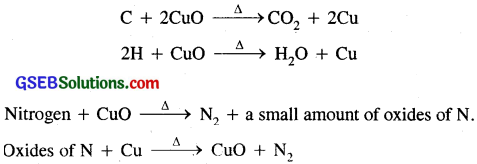
The volume of N2 thus collected over KOH, is measured in Scniffs nitrometer. It is reduced to NTP let V = Vol. in litres, knowing that 22.4 litres of N2 at STP/NTP weigh = 28g, the wt. of the N present in organic compound is called

Estimation of N in the organic compound by KJELDAHL’s method:
This is a more convenient method for estimation of N and is largely used to estimate N in fertilizers, food-stuffs, drugs etc. This method is not applicable to compounds contaning N directly linked to  or another N atom (as in diazo – N = N-). It is also not applicable to organic compounds containing N in the ring (as in pyridine C5H5N or quinoline).
or another N atom (as in diazo – N = N-). It is also not applicable to organic compounds containing N in the ring (as in pyridine C5H5N or quinoline).
A known weight of the organic compound is heated with cone. H2SO4 in the presence of H2SO4 and a little of CuSO4 of Hg in a long-necked flask called Kjeldahl’s flask. K2SO4 raises the B.Pt. of H2SO4 and CuSO4 acts as a catalyst.
N present in the organic compound is quantitatively converted into ammonium sulphate. (NH4)2SO4 thus obtained is boiled with excess of NaOH which is then absorbed in a known excess of a standard acid such as H2SO4 or HCl.
![]()
(NH4)2SO4 + 2NaOH → Na2SO4 + 2H2O + 2NH3
2NH3 + H2SO4 → (NH4)2SO4
The vol. of the acid unused is found by titrating against standard alkali.
2NaOH + H2SO4 → Na2SO4 + 2H2O
Applying the normality equation, normality and hence strength of NH3 or N is determined.
From there % of N can be estimated

Question 23.
Discuss the principle of estimation of halogens, sulphur and phosphorus present in an organic compound.
Answer:
Halogens, sulphur and phosphorus present in the organic comopund are estimated by CARIUS METHOD, detailed below.
Carius Method For Estimation of Halogens:
A known weight of the organic compound is heated with fuming nitric acid (HNO3) and a few crystalls of silver nitrate (AgNO3) in a sealed hard glass tube kept in a furnace under these conditions, C and H present in the organic compd. are converted to CO2 and H2O while halogen is converted to silver halide. The precipitates of silver halide are filtered washed, dried and weighed, knowing the wt. of substance taken, percentage of halogen is calculated as follows.
Let the weight of the organic compound taken = Wg.
Mass of the silver halide formed = x
% of Halogen in the compound
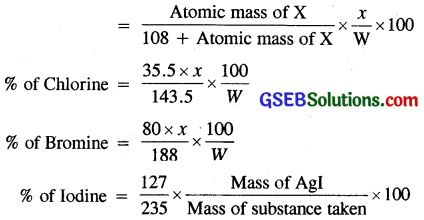
(ii) Estimation of Sulphur : In the Carius method, to estimate sulphur which is quantitatively converted to H2SO4, is precipitated by adding excess of Barium chloride solution :
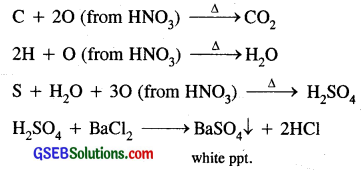
BaSO4 so precipitated is filtered, washed, dried and weighed knowing the mass of the substance taken (W) and the mass of BaSO4, percentage of sulphur can be calculated
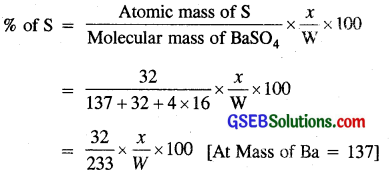
(iii) Estimation of Phosphorus : Phosphorus present in the organic compound in the Carius tube is oxidised by cone. HNO3, to phosphoric acid (H3PO4). It is precipitated as magnesium ammonium phosphate by adding magnesia mixture (a mixture containing MgCl2, NH4Cl and NH3)

The precipitate of magnesium ammonium phosphate is filtered, washed, dried and then ignited to give magnesium pyrophosphate.
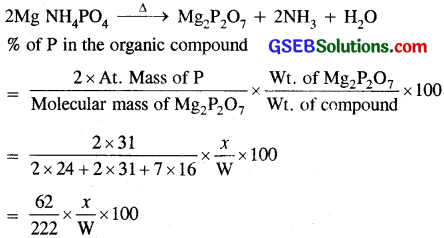
Question 24.
Explain the principle of paper chromatography.
Answer:
In paper chromatography, a special quality paper called chromatographic paper is used. Although paper consists mainly of cellulose the stationary phase in paper chromatography is not the cellulose but the water which is adsorbed or chemically bound to it.
The mobile phase is another liquid which is usually a mixture of two or three solvents with water as one of the components. It is a type of partition chromatography in which both the mobile phase and the stationary phase are liquids.
Paper chromatography works on the principle of partition, i.e., it is based upon continuous differential partitioning or distribution of the various components of the mixture between the stationary and the mobile phases. Here Recalled the retention factor is

The paper strip so developed is called the CHROMATOGRAM. If there is a mixture of compounds used, the spots of the separated coloured compounds are visible at different heights from the starting line and are identified by their Rf values. The spots of colourless compounds may, however, be observed either under UV light or by the use of an appropriate spray reagent.
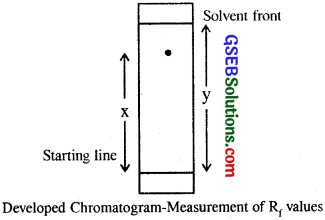
Question 25.
Why is nitric acid added to sodium extract before adding silver nitrate for testing halogens.
Answer:
Function of Nitric acid : When we test halogens present in the organic compound, we add nitric acid (HNO3) to the Lassaigne’s filterate or sodium extract to boil off H2S and HCN gases coming from the S and N if at all present in the organic compound
NaCN + HNO3 → NaNO3 + HCN
Na2S + 2HNO3 → 2NaNO3 + H2S
If cyanide and sulphide are not removed they will react with AgNO3
NaCN + AgNO3 → AgCN (white ppt.) + NaNO3
Na2S + 2AgNO3 → Ag2S (Black ppt.) + 2NaNO3
Question 26.
Explain the reason for the fusion of an organic compound with metallic sodium for testing nitrogen, sulphur and halogens.
Answer:
Before proceeding for testing of N, S or P in the given organic compound the organic compound is fused with metallic sodium. These elements are present in the organic compound in the formation of covalent bonds like N in urea (NH2-CO-NH2] or sulphur in thiourea [NH2CS NH2], By fusing the organic compound with sodium, these elements are converted into NaCN or Na2S or NaX-that is, ionic compounds which can be easily detected by ionic reactions.
![]()
Question 27.
Name a suitable technique of separation of the components from a mixture of calcium sulphate and camphor.
Answer:
Components calcium sulphate (CaSO4) which is an inorganic compound and does not sublime can be separated from camphor which is an organic compound and sublimes by the simple technique of SUBLIMATION, Sublimation involves the direct conversion of a solid into the gaseous state on heating without passing through the intervening liquid state and vice-versa on cooling. Camphor sublimes and gets-deposited on the walls of the cooler portion of the funnel and CaSO4 remains as such. The two components can thus be separated.
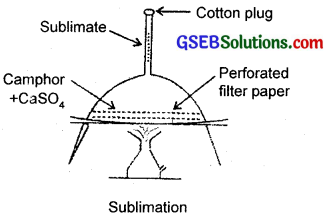
Question 28.
Explain why an organic liquid vaporises at a temperature below its boiling point in its steam distillation?
Answer:
In steam distillation the mixture boils when sum of vapour pressures of water and organic liquid becomes equal to the atmospheric pressure. Since the vapour pressure of water is appreciably higher than that of organic liquid, therefore, the organic liquid will vaporise at a temprature much lower than its normal boiling point.
Question 29.
Will CCl4 give white ppt. of AgCl on heating it with silver nitrate ? Give reason for your answer.
Answer:
CCl4 will not give a white ppt. of AgCl when it is treated with a solution of silver nitrate. It is because CCl4 is a covalent compound and hence does not ionise to give Cl– ions which is the essential requirement for the AgNO3 test.
![]()
Question 30.
Why is a solution of potassium hydroxide used to absorb carbon dioxide evolved during the estimation of carbon present in an organic compound?
Answer:
Carbon dioxide (CO2) is slightly acidic in nature. Hence KOH which is a strong alkali dissolves CO2 evolved from the compound containg carbon and reacts with it to form K2CO3. Increase in the weight of potash bulbs will give the weight of CO2 evolved.
2KOH(aq) + CO2(g) → K2CO3 + H2O(l)
Question 31.
Why is it necessary to use acetic acid and not sulphuric acid for acidification of sodium extract for testing sulphur by lead acetate test?
Answer:
For testing of sulphur present in the organic compound, the Lassaigne’s extract is acidified with acetic acid (CH3COOH) and not sulphuric acid because lead acetate is soluble and does not interfere with the test. If sulphuric acid (H2SO4) is used, lead acetate will react with H2SO4 itself to form white ppt. of PbSO4 as follows :

Question 32.
An organic compound contains 69% carbon and 4.8% hydrogen, the remainder being oxygen. Calculate the masses of carbon dioxide and water produced when O.2O g of this substance is subjected to complete combustion.
Answer:
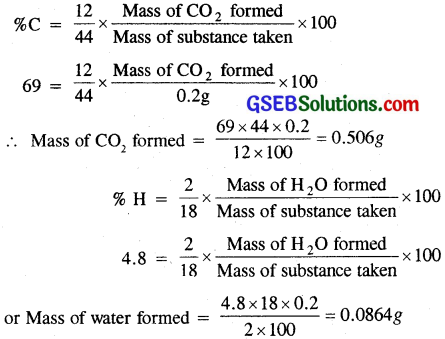
Question 33.
A sample of 0.50 g of an organic compound was treated according to Kjeldalil’s method. The ammonia evolved was absorbed in 50 ml of 0.5 M H2SO4. The residual acid required 60 mL of 0.5 M solution of NaOH for neutralisation. Find the percentage composition of nitrogen in the compound.
Answer:
Step-I.
To determine the volume of H2SO4 used
Volume of acid taken = 50 ml of 0.5 M H2SO4
= 25 ml of 1.0 MH2SO4
Volume of alkali used for neutralisation of excess of acid
= 60 ml of 0.5 M NaOH
= 30 ml of 1.0 M NaOH
Now 1 Mole of H2SO4 neutralises 2 moles of NaOH
2KOH + H2SO4 → Na2SO4 + 2H2O
∴ 3O ml of 1 M NaOH
∴ Volume of acid used by ammonia
= 25-15 .
= 10 ml.
Step-II:
To determine percentage of nitrogen in the compound 1 Mole of H2SO4 neutralises 2 Moles of NH3
∴ 10 ml of 1 MH2SO4 = 20 ml of I M NH3
But 1000 ml of 1 MNH3 contains 14g of Nitrogen
∴ 10 ml of 1M NH3 will contain N = \(\frac { 14 }{ 1000 }\) x 20
This is the amount of N present In 0.5 g of compd.
% N = \(\frac { 14 }{ 1000 }\) x \(\frac { 20 }{ 0.5 }\) x 100
= 56.0.
![]()
Question 34.
0.3780 g of an organic chloro compound gave 0.5740 g of silver chloride in Carius estimation. Calculate the percentage of chlorine present in the compound.
Answer:

Question 35.
In the estimation of sulphur by Carius method, 0. 468g of an organic sulphur compound afforded 0.668 g of barium sulphate. Find out the percentage of sulphur in the given compound.
Answer:
